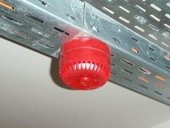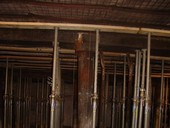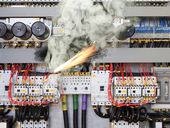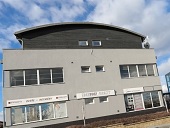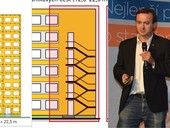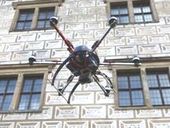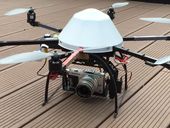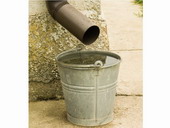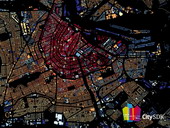This article contains a description of the fire detection and fire alarm system, as a part of the overall fire protection equipment of a buildings facilities and technology amenities; including principles of its design, installation and operation.
Archiv článků od 16.5.2016 do 10.10.2016
The floor system structure HURDIS is composed of a steel beam, of floor ceramic elements and of concrete. There are materials with different behavior in fire exposition. The paper deals with the analysis of the behavior of individual elements of floor structures affected by high temperatures. Knowledge is applied to the example of the assessment of the floor structure of the storehouses damaged by fire.
Emergency lighting is one of the most important species of fire safety equipment which determine the fire safety of buildings or other facilities. Emergency lighting is established for use in the event of failure of normal artificial lighting and is therefore supplied from the second independent source. Properly designed, highly functional and operational installation of emergency lighting is essential to ensure a quick and safe escape of people in case of emergency.
The annual total losses caused by fires in the Czech Republic (direct and indirect) are not negligible. The total amount of these damages is to a large extent also involved in fires caused by the operation of electrical wiring and equipment. In terms of fire protection in these cases remains a key issue rate of compliance with fire safety requirements in design, construction, and especially in the operation of these facilities. Currently, in addition to the system of Czech technical standards implemented a lot of new European standards which transpose the international requirements for testing, design, operation and maintenance of electrical wiring and equipment, which requires often the direct modification of existing CSN, in those parts which are contrary thereto. This situation logically caused societal need to address this issue in order to protect public interests, and comprehensively, using available European technical documents, specifications and national standards of EU member states, according to the current state of science and technology.
The paper is focused on the energy needs for preservation of food in retail food stores, which means cooling and freezing of food. The first part of the article is devoted to the issue of cold appliances in supermarkets, which include refrigeration and freezer boxes and furniture for distribution and sales. The second part of the article is based on the calculation of a refrigeration load and cooling demand for case study of a reference retail food store. The article aims to highlight the issue of energy need for preservation of food and defining of approach for design of general food refrigeration equipment of reference retail food store and to create conditions to establish energy-saving measures.
The paper is focused on the energy needs for preservation of food in retail food stores, which means cooling and freezing of food. The first part of the article is devoted to the issue of cold appliances in supermarkets, which include refrigeration and freezer boxes and furniture for distribution and sales. The second part of the article is based on the calculation of a refrigeration load and cooling demand for case study of a reference retail food store. The article aims to highlight the issue of energy need for preservation of food and defining of approach for design of general food refrigeration equipment of reference retail food store and to create conditions to establish energy-saving measures.
The article is focused on ambivalent features of systems intelligent building management from the obligatory requests on fire safety point of view. It insists that reliable and functional detection is the basic predetermination to effective solution in fire case but it is not sufficient to the total fire protection provision. The complex solution of the problematics involves many further steps and provisions of both, technical and organizational character.
External Thermal Insulation Composite System (ETICS) still plays an important role in increasing the energy efficiency of buildings – the bigger is the demand, the thicker is just the insulation layer. In August 2016, a new version of basic fire safety Czech standard ČSN 73 0810 comes into action. Changes stated in this document are related, among other, to ETICS and it significantly changes the use of combustible and incombustible thermal insulation on facades. This article intends to point out the essentials of the mentioned problematics.
Presented text discusses the use of RPAS (Remotely Piloted Aerial System) in the building industry and heritage preservation. It provides information of various case studies and shows examples. For the purposes of building industry and technological area monitoring multicopter systems are mainly used. They have more complex control, but they can be successfully navigated in very low heights and low speeds around and above the object. Safe handling and ensuring the area after agreement with the owner or facility manager is crucial for their use.
Presented text discusses RPAS (Remotely Piloted Aerial System) in terms of history, legislation and its possible use especially in the civil sector. RPAS, often called UAV / UAS or “drones” in slang are a phenomenon of recent years. They present modern and popular technology that has undergone an unprecedented boom thanks to miniaturization of electronics, control and navigation equipment, high-performance battery development as well as individual components now available for affordable prices. Safe manipulation and current limits of applicability are indispensable and must be taken into account.
Energy-efficient buildings research is one chapter of General Programme for Research and Innovation Horizont 2020 (2014 - 2020) which helps reaching the aims of european energy policy. First part of the article deals with characteristics of private-public partnership called Energy-efficient buildings (PPP EeB) that was founded for this purpose during previous General programme (2007 - 2013) and sums up projects PPP EeB supported in both programmes so far. Second part of the article deals with Czech participation in this programmes and describes topics of nearest Programme Hotizont calls for the year 2017.
The active fire safety devices, by which are in the contribution meant especially electric fire alarms, stabile fire extinguishing means and devices for smoke and heat removal, are an important part of building security systems. For the proper function of these systems it is necessary to pay attention to the priority how to put into operation the particular device, their coordina tion and interaction between them.
The principles of the prioritizing how to put into the operation the individual active fire safety devices are described on the basis of the reasons for the devices installation and their priority or eventually secondary protection targets. The attention is paid also to the coordina tion of the fire safety means.
Energy-efficient buildings research is one chapter of General Programme for Research and Innovation Horizont 2020 (2014 - 2020) which helps reaching the aims of european energy policy. First part of the article deals with characteristics of private-public partnership called Energy-efficient buildings (PPP EeB) that was founded for this purpose during previous General programme (2007 - 2013) and sums up projects PPP EeB supported in both programmes so far. Second part of the article deals with Czech participation in this programmes and describes topics of nearest Programme Hotizont calls for the year 2017.
The aim of the article is to provide several concrete solutions and applications of Smart Cities that are already being applied in the world and try to describe their contribution to urban residents. We focus on the first two of the six key areas of Smart City – Smart Government and Smart Transportation.
zpět na aktuální články
